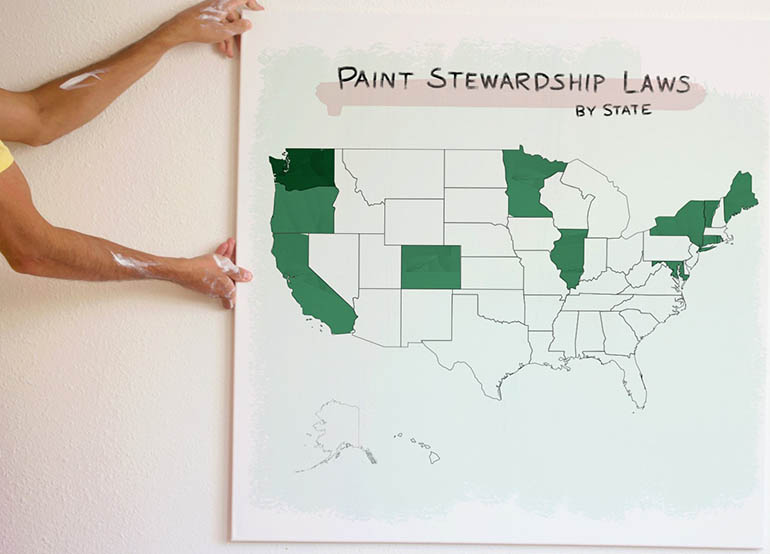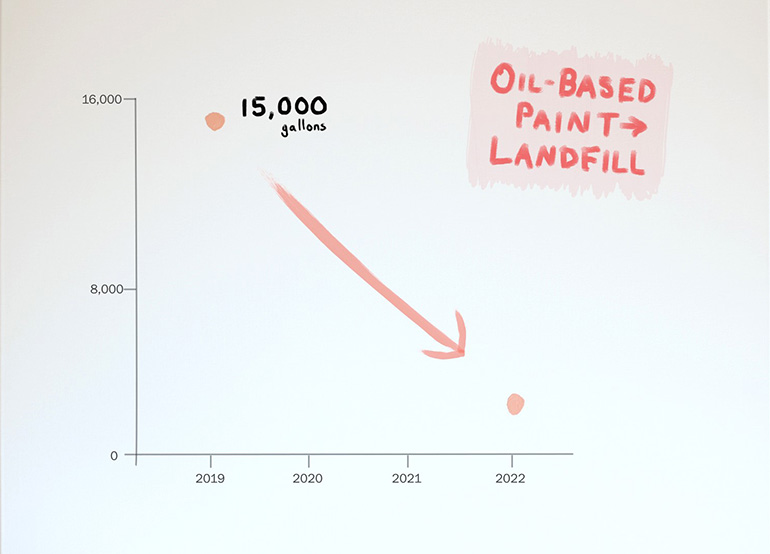VIDEO: ‘We’re pivoting from a take, make, and waste economy:’ A highly successful paint recycling program shows how extended producer responsibility reduces waste, protects human and environmental health
Summary
The success of a statewide rule that holds producers responsible for their own products, such as leftover paint, is a key component of Re+, King County’s initiative to prevent pollution, protect human and environmental health, and keep waste management costs in check.
News
A state law that went into effect in 2020 promoting product stewardship dramatically reduced the amount of oil-based paint sent to the regional landfill in Maple Valley, preventing waste and protecting the natural environment in King County.
An estimated 15,000 gallons of oil-based paint were sent to Cedar Hills Regional Landfill in 2019, a year before the state law applied the principles of extended producer responsibility. There was almost none when King County’s Solid Waste Division measured again in 2023. More than 680,000 gallons of paint were recycled statewide last year.
Extended producer responsibility is a policy approach that places greater responsibility on companies to manage the lifecycle of a product. From design to disposal, extended producer responsibility tasks producers in Washington with finding innovative ways to ensure the proper management of products such as paint and batteries.
“Producers, governments, and consumers – we all have a shared responsibility to ensure that products are managed and disposed of properly,” said Maythia Airhart, Director of the Hazardous Waste Management Program in King County. “Extended producer responsibility uses policy and regulations to require producers to take on this responsibility and expands access to recycling and disposal services for the public. This allows everyone to play a part in protecting public health and the environment in our region.”
Extended producer responsibility is a pillar of Re+, a King County initiative to transition the region’s waste system to a sustainable circular economy, simultaneously cutting greenhouse gas emissions and protecting human and environmental health.
Like other common household products, paint needs to be used, stored, and disposed of correctly to protect human and environmental health. Oil-based paints contain ingredients that can cause throat and lung irritation and damage if breathed in or accidentally swallowed. Chemicals in oil-based paints can also gas off volatile organic compounds that pollute the air.
Latex paints are less toxic but are often disposed of incorrectly, which can damage drains and pollute waterways.
“Many people in Washington have old cans of paint in their garages and storerooms and this law helps make it easy for people to turn that paint in for it to be recycled. This helps reduce greenhouses gases, both associated with the manufacturing and transport of the new paint but also reduces the load at the landfill where the paint can off gas harmful chemicals,” said Heather Trim, Executive Director of Zero Waste Washington.
The Legislature in 2019 passed a law that established an industry-led program to ensure the management of leftover paint.
“By partnering with paint producers, we’re able to make it easier for people to get rid of their leftover paint, and keep paint out of the landfills,” said Rep. Strom Peterson (D-21), who sponsored the paint stewardship bill passed in 2019 that established an industry-led program to ensure the management of leftover paint. “The passage of the paint stewardship law is a successful example of how producers can take more responsibility for the waste their products generate.”


PaintCare, a nonprofit organization that runs paint stewardship programs across the United States, began operating in Washington in 2021. There are now 65 paint retail locations and household hazardous waste facilities in King County where unwanted paint can be dropped off for recycling. PaintCare Washington’s website features a searchable map for drop-off locations.
“PaintCare has collected more than 2.5 million gallons of leftover paint for recycling and reuse in Washington since the program began,” said Lauren Scher, Washington and Oregon Program Manager for PaintCare. “Thanks to partnerships with local governments and businesses such as neighborhood paint stores that serve as convenient drop-off sites, our program has made it easier than ever to recycle paint in King County.”
With extended producer responsibility policies in place for other products in Washington, including electronics, mercury-containing lights, and unused medicines, King County wants to bring this successful model to other products through its Re+ Initiative which aims to recover nearly 70% of the material currently sent to the landfill through improved reuse, recycling, and composting efforts.
Re+ identifies statewide extended producer responsibility legislation for packaging and paper as a critical action to help to achieve that diversion goal.
“We know that these policies work and that’s why EPR policies are a strong accelerator for our Re+ strategy in King County,” said Adrian Tan, Policy and Market Development Manager for King County Solid Waste. “Extended producer responsibility is key to pivoting our region from a ‘take, make, and waste’ approach to a circular economy that reduces waste and carbon emissions, increases recycling and reuse, and protects the health of people and the environment.”
Multimedia
- VIDEO: Recycling paint for environmental health
- VIDEO: Short vertical version of feature video
- PHOTO GALLERY: Recycling paint for environmental health
- TRACKS: An interactive map of environmental stewardship
Resources
- Searchable map of paint drop-off locations in Washington
- Hazardous waste drop-off locations in King County
- King County's Re+ initiative
Quotes
By partnering with paint producers, we’re able to make it easier for people to get rid of their leftover paint, and keep paint out of the landfills. The passage of the paint stewardship law is a successful example of how producers can take more responsibility for the waste their products generate.
Producers, governments, and consumers – we all have a shared responsibility to ensure that products are managed and disposed of properly. Extended producer responsibility uses policy and regulations to require producers to take on this responsibility and expands access to recycling and disposal services for the public. This allows everyone to play a part in protecting public health and the environment in our region.
PaintCare has collected more than 2.5 million gallons of leftover paint for recycling and reuse in Washington since the program began. Thanks to partnerships with local governments and businesses such as neighborhood paint stores that serve as convenient drop-off sites, our program has made it easier than ever to recycle paint in King County.
We know that these policies work and that’s why EPR policies are a strong accelerator for our Re+ strategy in King County. Extended producer responsibility is key to pivoting our region from a ‘take, make, and waste’ approach to a circular economy that reduces waste and carbon emissions, increases recycling and reuse, and protects the health of people and the environment.
Many people in Washington have old cans of paint in their garages and storerooms and this law helps make it easy for people to turn that paint in for it to be recycled. This helps reduce greenhouses gases, both associated with the manufacturing and transport of the new paint but also reduces the load at the landfill where the paint can off gas harmful chemicals.
Contact
Joe Basile, Solid Waste Division, 206-848-0496

 Translate
Translate